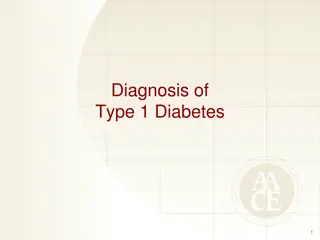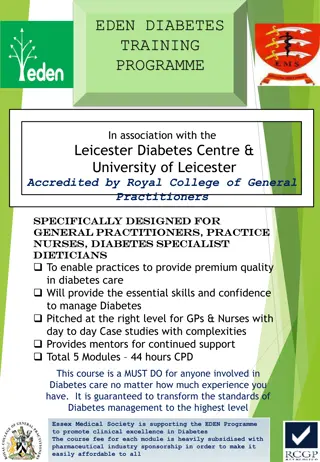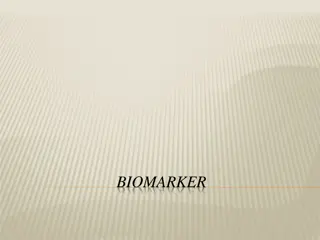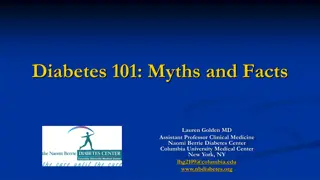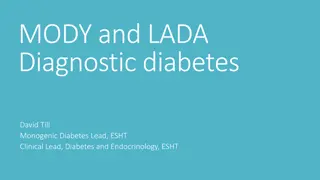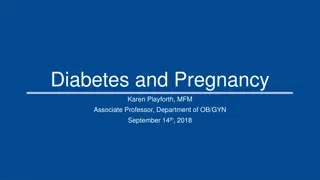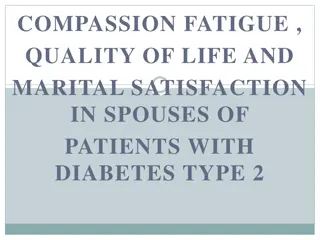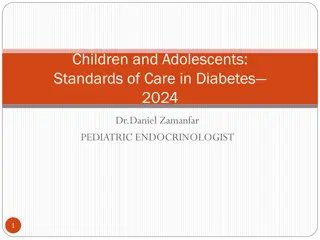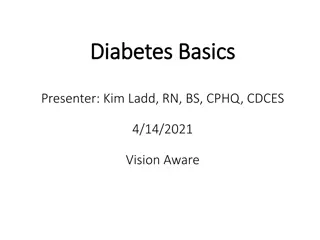Maturity-Onset Diabetes of the Young (MODY)
Maturity-onset diabetes of the young (MODY) is a type of diabetes with autosomal dominant inheritance, often characterized by non-insulin-dependent features. The prevalence of MODY is estimated to be 1-5%, with certain subtypes like GCK-MODY and HNF1A-MODY being more common. Genetic testing can help diagnose MODY and differentiate it from type 1 and type 2 diabetes. Recognizing MODY early can lead to personalized treatment strategies and better management of the condition.
Download Presentation

Please find below an Image/Link to download the presentation.
The content on the website is provided AS IS for your information and personal use only. It may not be sold, licensed, or shared on other websites without obtaining consent from the author.If you encounter any issues during the download, it is possible that the publisher has removed the file from their server.
You are allowed to download the files provided on this website for personal or commercial use, subject to the condition that they are used lawfully. All files are the property of their respective owners.
The content on the website is provided AS IS for your information and personal use only. It may not be sold, licensed, or shared on other websites without obtaining consent from the author.
E N D
Presentation Transcript
Mild asymptomatic hyperglycemia Soheila Sadeghi
1) What is the diagnosis ? 2) What are the differences between MODY and type 1 , 2 DM ? 3) MODYs subtypes? 4) Indications for genetic testing ? 5) What are the Benefits of Diagnosing MODY? 6) Treatment ? 7) Complication?
Maturity-onset diabetes of the young (MODY) was first defined clinically as nonketotic, non-insulin-dependent diabetes mellitus of early onset, with autosomal dominant inheritance The prevalence of MODY has been estimated to be 1-5% In all studies, GCK-MODY and HNF1A-MODY are the most common subtypes
6.5% of children with antibody-negative diabetes have a form of MODY single gene mutation that leads to a defect in beta cell insulin secretion in response to glucose stimulation have strong family histories of diabetes spanning at least 3 generations
What are the differences between MODY and type 1 , 2 DM ?
prevalence Age at onset of diabetes Hyperglycemia Circumstances of diagnosis OGTT HNF4A (MODY 1) 5% - 10% Usually postpubertal, mean age 30 years Variable postprandial increases with time sensitivity to IS macrosomia and transient neonatal hyperinsulinism(h ypoglycemia) large increase (90 mg/dl) GCK (MODY 2) 30% - 60% Very early but may be discovered in adults Screening gestational diabetes mild increases (54 mg/dl) Mild fasting hyperglycemia long-term stability HNF1A (MODY 3) 30% - 60% Usually postpubertal, mean age 20 years Variable postprandial increases with time sensitivity to IS Screening gestational diabetes large increase (90 mg/dl) HNF1B (MODY 5) less than 5% Highly variable Variable increases with time Association of diabetes and renal abnormalities _
Clinical Features Lab data complication HNF4A (MODY 1) -Macrosomia - transient hyperinsulinaemic Hypoglycaemia - familial hyperlipidaemia, Decreased HDL-C levels prone to microvascular complications GCK (MODY 2) -Mild insulin deficiency -Low birth weight infants -Neonatal Diabetes Mild hyperglycemia low risk of microvascular (and possibly macrovascular) HNF1A (MODY 3) -Pancreatic exocrine failure -glycosuria Elevated HDL-C Lower HsCRP levels high risk of microvascular and macrovascular HNF1B (MODY 5) -Congenital anomalies of urinary and genital tracts - Agenesis of pancreatic tail and body -juvenile gout -primary hyperparathyroidism Hypomagnesemia Hyperuricemia Abnormal liver enzyme Microvascular complications
Indications for genetic testing ?
Indications for genetic testing include: Strong FH of DM presenting in the second to fifth decade of life Leanness Autoantibody negative Features inconsistent with DM1 or DM2 such as: Low renal threshold A large increase in blood sugar in OGTT Lower than expected CRP levels Lower than expected HDL-C High insulin sensitivity; although insulin resistance in a small number of MODY Children diagnosed with DM1 with antibody-negative Elevated C peptide levels
What are the Benefits of Diagnosing MODY? The diagnosis of monogenic diabetes has many consequences in terms of prognosis, therapeutics and family screening
Patients with GCK-MODY may be misdiagnosed as having type 1 or 2 DM and may receive unnecessary treatments (oral agents or even insulin) They should be reassured about the stability of hyperglycemia and the low risk for vascular complications Their followups may be less stringent Family screening is easy, on the basis of increased fasting blood glucose or A1C levels . It may be particularly useful in women of child- bearing age Good prognosis
In patients with HNF1A-MODY or HNF4A-MODY : - Switching from an unnecessary insulin therapy to oral treatment with sulfonylureas or glinides, even long after the onset of diabetes - Careful followup is necessary because insulin secretion decreases with time - Encourage to maintain normal body weights because obesity may accelerate the onset of diabetes - Identifying siblings who carry the mutation is mandatory to prevent the insidious onset of vascular complications and, in women, to avoid unrecognized hyperglycemia in the early stages of pregnancy
Patients with HNF1B-MODY should be systematically evaluated for damage to other organs because of the progression of insulin secretion defects and of renal disease, insulin therapy is needed
Treatment Treatment of the hyperglycemia in GCK is generally unnecessary except during pregnancy ( ins to prevent excess fetal growth,50%, if the fetus does not carry the MODY gene ) Sulfonylureas have been shown to be effective in treating HNF1A Similar response to sulfonylureas has been reported in HNF4A HNF1B do not generally respond to sulfonylureas and typically require insulin early
Some patients with HNF-related MODY are at increased risk for developing tumours. Patients with HNF1A-MODY have a 5% to 10% risk for liver adenomatosis This risk deserves screening by liver ultrasound and avoidance of estrogen- containing contraceptives because they may favour the development of liver adenomas.
In patients with HNF1B-MODY, a biallelic inactivation of HNF1B has been reported in chromophobe renal carcinomas HNF1B may also be a suppressor gene for some ovarian cancers.
A 35-year-old woman, G3P1 Her first pregnancy in 2005 resulted in an early miscarriage. Her second pregnancy in 2014 was complicated by GDM diagnosed at 13 weeks gestation and managed with a multiple daily insulin regimen from 20 weeks. Her pre-pregnancy weight was 52 kg (BMI 21.4 kg/m2) and gestational weight gain was 13 kg. Following induction of labour at 38+2 weeks gestation she had a vaginal delivery of a healthy girl weighing 3200 g. She did not attend a postnatal 75-g oral glucose tolerance test (OGTT).
The couple were non-consanguineous. There was a family history of impaired glucose tolerance affecting her sister and brother. Another sister had GDM in both her pregnancies and her father was treated for Type 2 diabetes mellitus. There was no family history of significant congenital malformations.
In the woman's recent pregnancy (2015) she was diagnosed with GDM at 13 weeks gestation on a 75-g OGTT The woman's pre-pregnancy weight was 56 kg (BMI 23.0 kg/m2). HbA1c at 14 weeks was 41 mmol/mol (5.9%). At 18 weeks she was commenced on insulin and metformin. Ultrasonography at 12+6 weeks gestation detected no abnormality A routine morphology scan at 19+2 weeks gestation showed absence of the sacral vertebrae and abnormalities of the lumbar vertebrae at L4/L5, consistent with a Type III sacral agenesis.
A fetal MRI confirmed absence of the sacrum and coccyx and attenuation of the lower lumbar vertebrae. The spinal canal terminated abruptly at L4, suggestive of caudal regression syndrome. After multidisciplinary team consultation, the family elected to terminate the pregnancy. Postpartum fasting blood glucose was 6.7 mmol/l and HbA1c was 43 mmol/mol (6.1%), consistent with abnormal glucose tolerance but not diagnostic of diabetes.
A 75-g OGTT was then performed at 3 months postpartum. The elevated fasting glucose and low increment (fasting blood glucose 7.4 mmol/l, 1-h blood glucose 9.3 mmol/l, 2-h blood glucose 7.3 mmol/l) were strongly suggestive of a diagnosis of GCK- MODY, especially given her normal BMI and family history. Type 1 diabetes mellitus antibodies were negative.
The woman was counselled about the implications of the diagnosis for diabetes management in future pregnancies, including a 50% risk of offspring inheriting this mutation. Mutation analysis of the GCK gene identified a novel heterozygous GCK missense mutation, Sacral agenesis is a rare form of developmental sacral abnormality(subtype of caudal regression syndrome)
Caudal regression syndrome is a cardinal feature of diabetic embryopathy. The relative risk of caudal regression syndrome in infants born to mothers with pre-GDM is 170 200 times higher than in the general population Sacral agenesis is a rare form of sacral abnormality affecting 0.005% to 0.1% of pregnancies. It is a subtype of the caudal regression sequence, a cardinal feature of diabetic embryopathy. It is not thought to be strongly associated with major abnormalities, but with insufficient data and relatively low numbers of pregnancies in women with GCK-MODY
In contrast to the well established link between glycaemic control in pre-GDM and congenital abnormalities, it is unclear whether a similar association exists with the mild hyperglycaemia seen in GCK-MODY However, the risk increase was minimal at the HbA1c levels typically seen in GCK-MODY of 38 56 mmol/mol (5.6 7.3%),
Miss A. was a 21-year-old fit and well woman without a prior documented significant medical or surgical history, who was referred to our antenatal clinic by her midwife because a bicornuate uterus was discovered An HbA1C, routinely done in New Zealand for diabetes screening, was mildly elevated at 41mmol/mol(5.9 %). She had persistent hyperglycemia and investigations to exclude type I diabetes were performed. The anti-GAD antibodies and Islet Cell Cytoplasmic autoantibodies came back negative.
normal renal ultrasound a right multicystic dysplastic kidney in the fetus with no other abnormality A repeat anatomy scan at 28 weeks showed a shrinking right kidney from 4 cm to 2.5 cm as well as a prominent in size and slightly echogenic left kidney hyperuricemia (0.37mmol/L) hypomagnesaemia
At 21 weeks when Miss A. was hospitalized for an unprovoked episode of a minor antepartum hemorrhage, MODY-5 was suspected for the first time given her unexplained early onset diabetes and uterine malformation. The patient s family history is strongly positive for diabetes and renal cysts have been diagnosed in her maternal cousin and her child.
Due to the diabetes diagnosis growth scans of the female fetus were performed every 4 weeks. The fetus remained in breech position during the course of the pregnancy. At 29 + 5 weeks = a polyhydramnios of 31 cm At 32 weeks = threatened preterm labor and was started on Betamethasone intramuscularly for lung maturation and Nifedipine orally for tocolysis. discharged after 48 hours.
At this point the baby was on the 96th centile of the Australasian Society of Ultrasound in Medicine ASUM charting for growth with an estimated fetal weight of 2.34kg. The amniotic fluid index had reduced to 21. She represented after 5 days with premature prelabor rupture of membranes and went into spontaneous labor and the baby was delivered vaginally from breech position.
The baby girl was born alive, and a birth weight of 2105 g. The physical examination was normal. However, at one week postpartum a neonatal ultrasound scan confirmed an absent right kidney and the presence of a bicornuate uterus Genetic testing was arranged and showed a heterozygous deletion of the HNF1B gene.
We suggest that genetic testing should be offered to young female patients with uterine abnormalities and otherwise unexplained diabetes even in the absence of kidney abnormalities on imaging if kidney impairment is present on laboratory functions.
The optimal care for pregnant patients with MODY-5 due to HNF1B mutations is multidisciplinary and involves obstetricians, endocrinologists, geneticists, nephrologists, and pediatricians. Despite the more common association of MODY-5 with renal malformation we think that genetic testing is also warranted in cases where genital malformations are diagnosed and renal impairment is only present on laboratory testing.
Miss S, a 19-year-old woman, presented to antenatal clinic at 19 weeks gestation for a first consultation because of a preexisting hepatocyte nuclear factor ? ? (HNF-1? ?) mutation causing MODY 3 diabetes Since age of 11 years when her condition first became apparent through recurrent mucosal candidiasis and mild postprandial hyperglycaemia. Due to a strong family history of diabetes and negative testing for type I diabetes, an HNF1? ? gene mutation was suspected and subsequently confirmed on molecular genetic testing.
The patient was initially successfully treated with the sulfonylurea (SU) gliclazide, which more recently was switched to insulin due to increasing hyperglycaemia. The father of the fetus is a 21-year-old man also well known to endocrinology and diabetes teams from age of 9 years, due to persistent mild hyperglycaemia and very significant family history of diabetes (Figure 2). Genetic testing for a Glucokinase (GCK) mutation was performed asymptomatic and did not require any further treatment
She was managed with insulin glargine (Lantus) daily and insulin aspart (Novorapid) with meals, and insulin requirements gently increased over the pregnancy, From 28 weeks, doses were further reduced, until she presented to the emergency department at 33+3 weeks of gestation for frequent hypoglycaemia. The patient never developed hypertension, and laboratory screening for preeclampsia was performed multiple times and was always within normal limits.
Fetal growth until this presentation had been measured by fortnightly ultrasound and was on the 50th centile Given the unknown significance of the falling insulin requirements, biweekly monitoring of fetal wellbeing via Doppler measurements was commenced, which was satisfactory at all times. At 34+3 weeks of gestation the patient went into spontaneous labour and delivered a healthy baby girl via forceps, weight 2.22kg
Postnatal genetic testing in the baby showed a heterozygous mutation for the maternal familial likely nonpathogenic HNF1A gene variant
In a pregnancy where the mother is affected by MODY 2 the fetus will not inherit the GCK mutation in 50% of cases, and will respond to maternal hyperglycaemia by excess insulin production and therefore excess growth (by approximately 550 700g) [2]. Alternatively, if the fetus does inherit the GCK abnormality it will sense the maternal hyperglycaemia as normal, produce normal amounts of insulin, and have normal growth







